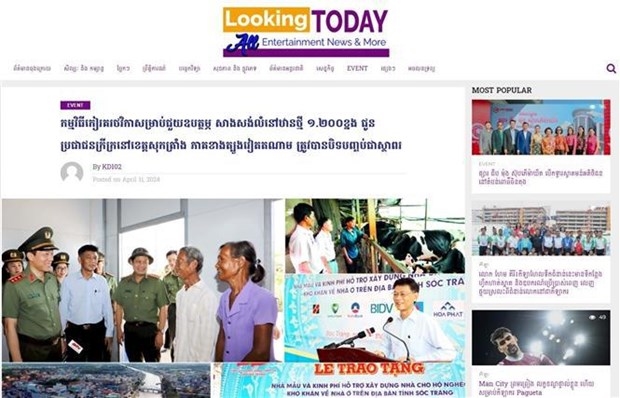 |
A screetshot of the article published on the news portal lookingtoday.com
of the information centre DAP NEWS. (Source: VNA) |
On April 12, Cambodia's national news agency AKP published an article about Soc Trang province in Vietnam's Mekong Delta, which is home to the largest population of Khmer ethnic minority people, at approximately 362,000, accounting for 30.18% of the province's population. The article underlined the close cultural and ethnic ties between the Khmer in Soc Trang and those in Cambodia.
AKP quoted Ho Thi Cam Dao, Permanent Deputy Secretary of the provincial Party Committee as saying that the material and spiritual lives of local Khmer people have gradually been improved, with the poverty rate within their community decreasing by 3.86%.
The article said the outcomes stemmed from the local administration's efforts in implementing programmes and projects targeting the group, including a 60-billion-VND programme to construct 1,200 houses for the poor, completed early in 2024. Moreover, it said Vietnam’s national programme aimed at socio-economic development in ethnic minority and mountainous areas also includes direct support measures regarding housing, agricultural land, water for daily use, vocational training, and employment.
Meanwhile, on April 11, the news portal lookingtoday.com of the information centre DAP NEWS also published an article about the programme on building 1,200 houses for poor families, which was initiated by Vietnam's Ministry of Public Security.
It cited Secretary of the Soc Trang Party Committee Lam Van Man as saying that the initiative is significant in motivating local poor households to overcome hardships and achieve sustainable poverty eradication.
Earlier, the online news site domreynews.com published a detailed analysis by Uch Leang, a researcher at the Royal Academy of Cambodia (RAC), noting the visible improvements and transformations in regions of Vietnam with large Khmer populations, such as Soc Trang, Tra Vinh, Kien Giang, An Giang, and Bac Lieu. The expert highlighted the advancements in rural transport, health care, and education, among others.
The scholar said in addition to ramping up investment in substantial infrastructure projects, local administrations in these regions have also implemented policies supporting Khmer people’s production activities by facilitating their access to preferential loans and promoting the development of sustainable agricultural economic models. These measures have provided necessary conditions and motivation for these communities to enhance production, increase incomes, and stabilise their lives./.